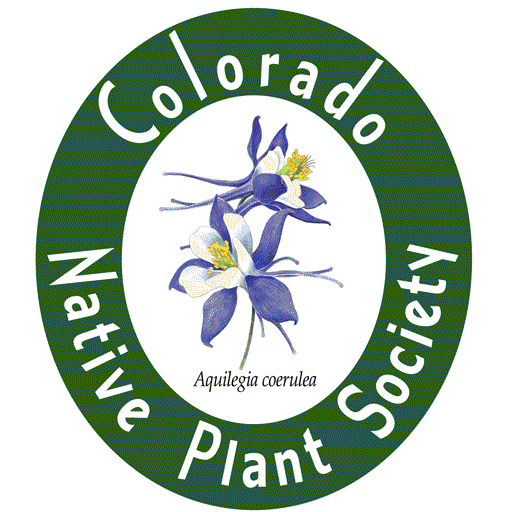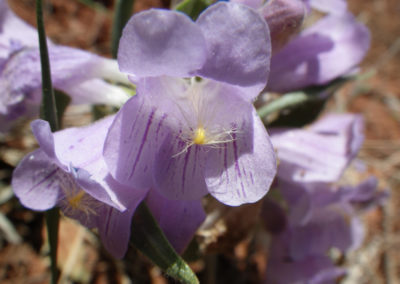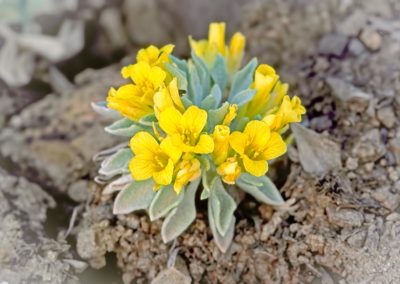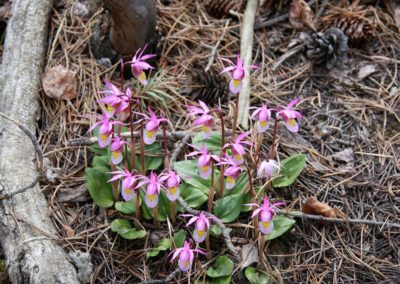


Colorado Plants and Habitats
Diversity of Life Zones
One of the reasons that Colorado plants and habitats have such a diverse flora is that our state has six altitude life zones. According to the Merriam Webster Dictionary, a life zone is defined as being “a region characterized by specific plants and animals.” In Colorado our life zones occur primarily, but not completely, because of our vast variation in altitude. Our lowest point is 3,315 feet on our eastern border where the Arikaree River crosses into Kansas. Our highest altitude is on Mount Elbert, at 14,433 feet, 12 miles southwest of Leadville in Lake County.
Our life zones do not only occur because of altitude, however, but also because of annual precipitation. The change in flora due to altitude is visually evident as you climb from the plains to the alpine.
Eastern Plains
From our lowest to highest points here are our six alpine life zones: The eastern prairie, which occurs from 3,315′ to about 6,000′ is dry, primarily grasslands. Annual precipitation varies from about 12” in the Arkansas Valley to 18” in the northeast and southeast corners of the state and gradually increase as one moves from east to west toward the mountains. The foothills occur from about 6,000′ to 8,000′ and with slightly higher precipitation are often dominated by shrub communities, consisting of such dry adapted species as Gambel oak and Mountain Mahogany.
Montane
The montane life zone occurs from about 8,000′ to 10,000′ and again, the moisture increases to the range of 25” – 30” per year. Here one finds forests dominated by species like Ponderosa Pine which are well adapted to dry, fire prone ecosystems.
Alpine and Sub-Alpine
Moving higher into the subalpine at 10,000′ – 11,500′, moisture increases toward 40” per year and the forests change to Englemann spruce and subalpine fir, species more adapted to more moisture and frigid snow-filled winters. Then to the alpine above,11,500′ the weather is too harsh and the trees drop away and the plant communities change to alpine fell-fields and tundra.
Continental Divide
In the attached map, one can see that Colorado is split down the middle by the Continental Divide, where all of the rivers on the east flow toward the Mississippi River and those on the west flow toward California. As one continues west, the altitudes drop down to those similar to the eastern plains, ranging from 4,336′ where the Colorado River crosses the western boundary into Utah up to the 6,000′ foothills.
Semi-desert Shrublands
The flora in this altitude life zone, however, is very different from that of the eastern plains. It is called semi-desert shrublands because it is dominated by desert shrubs like sagebrush and saltbush which thrive in drier ecosystems. The annual precipitation here is only 8” to 14” per year, and is evenly spread throughout the year, with slightly higher amounts falling in the winter. On the eastern plains, 70 – 80% of the annual precipitation occurs during the growing season, which is ideal for grasses.
In the section below we investigate our six altitude life zones, describing some of the most important plant communities and the native plants most likely to occur in that zone.
For more information on each Life Zone, and to see photos, scroll down, or click on the boxes under the map.
Colorado Altitude Life Zone Map
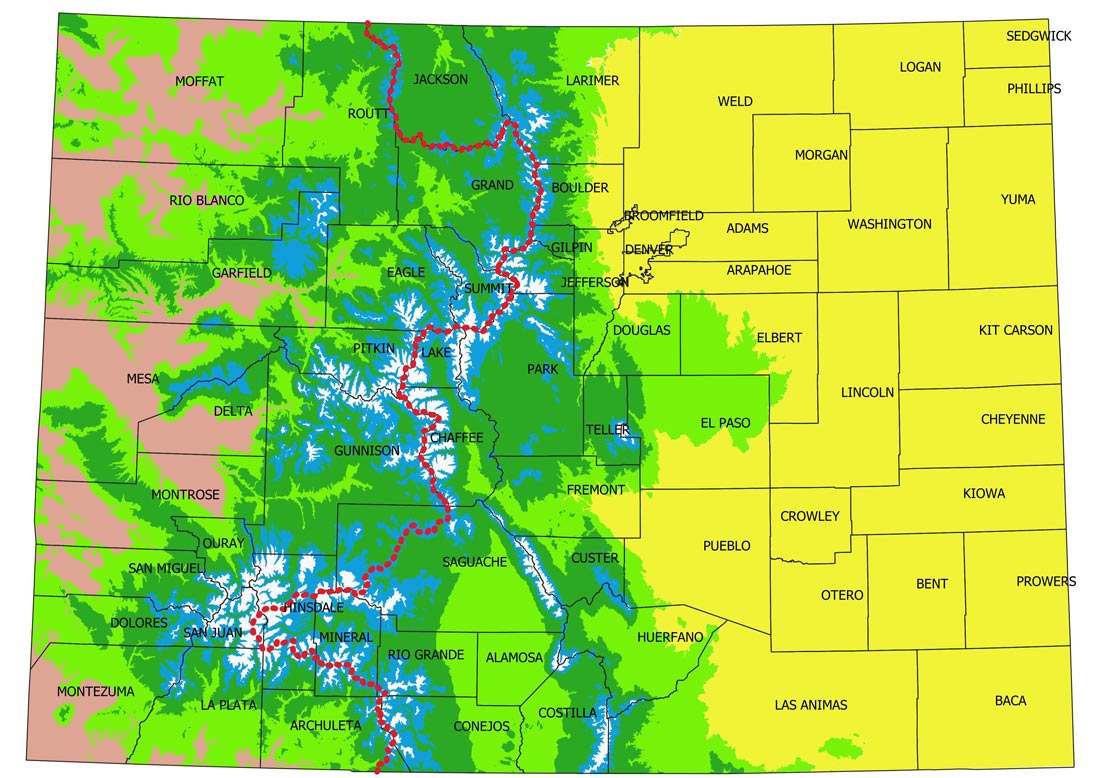
Click on each zone for more information and photos
References
Climate of Colorado, Colorado State University
North American Bryophyte Herbaria
Consortium of North American Lichen Herbaria
The Flora of Colorado – Jennifer Ackerfield
Colorado Flora, Eastern Slope, vol. 4, William Weber & Ron Wittmann
Colorado Flora, Western Slope, vol. 4, William Weber & Ron Wittmann
Bryophytes of Colorado, William Weber & Ron Wittmann
Peterson Field Guide to Mushrooms, Kent H. McKnight/Vera B. McKnight
Common Rocky Mountain Lichens, Larry L. St. Clair
Diversity of Life Zones
One of the reasons that Colorado plants and habitats have such a diverse flora is that our state has six altitude life zones. According to the Merriam Webster Dictionary, a life zone is defined as being “a region characterized by specific plants and animals.” In Colorado our life zones occur primarily, but not completely, because of our vast variation in altitude. Our lowest point is 3,315 feet on our eastern border where the Arikaree River crosses into Kansas. Our highest altitude is on Mount Elbert, at 14,433 feet, 12 miles southwest of Leadville in Lake County.
Our life zones do not only occur because of altitude, however, but also because of annual precipitation. The change in flora due to altitude is visually evident as you climb from the plains to the alpine.
Eastern Plains
From our lowest to highest points here are our six alpine life zones: The eastern prairie, which occurs from 3,315′ to about 6,000′ is dry, primarily grasslands. Annual precipitation varies from about 12” in the Arkansas Valley to 18” in the northeast and southeast corners of the state and gradually increase as one moves from east to west toward the mountains. The foothills occur from about 6,000′ to 8,000′ and with slightly higher precipitation are often dominated by shrub communities, consisting of such dry adapted species as Gambel oak and Mountain Mahogany.
Montane
The montane life zone occurs from about 8,000′ to 10,000′ and again, the moisture increases to the range of 25” – 30” per year. Here one finds forests dominated by species like Ponderosa Pine which are well adapted to dry, fire prone ecosystems.
Alpine and Sub-Alpine
Moving higher into the subalpine at 10,000′ – 11,500′, moisture increases toward 40” per year and the forests change to Englemann spruce and subalpine fir, species more adapted to more moisture and frigid snow-filled winters. Then to the alpine above,11,500′ the weather is too harsh and the trees drop away and the plant communities change to alpine fell-fields and tundra.
Continental Divide
In the attached map, one can see that Colorado is split down the middle by the Continental Divide, where all of the rivers on the east flow toward the Mississippi River and those on the west flow toward California. As one continues west, the altitudes drop down to those similar to the eastern plains, ranging from 4,336′ where the Colorado River crosses the western boundary into Utah up to the 6,000′ foothills.
Semi-desert Shrublands
The flora in this altitude life zone, however, is very different from that of the eastern plains. It is called semi-desert shrublands because it is dominated by desert shrubs like sagebrush and saltbush which thrive in drier ecosystems. The annual precipitation here is only 8” to 14” per year, and is evenly spread throughout the year, with slightly higher amounts falling in the winter. On the eastern plains, 70 – 80% of the annual precipitation occurs during the growing season, which is ideal for grasses.
Colorado Altitude Life Zone Map

Click on each zone below for more information and photos
– – – – – – Continental Divide
References
Climate of Colorado, Colorado State University
North American Bryophyte Herbaria
Consortium of North American Lichen Herbaria
The Flora of Colorado – Jennifer Ackerfield
Colorado Flora, Eastern Slope, vol. 4, William Weber & Ron Wittmann
Colorado Flora, Western Slope, vol. 4, William Weber & Ron Wittmann
Bryophytes of Colorado, William Weber & Ron Wittmann
Peterson Field Guide to Mushrooms, Kent H. McKnight/Vera B. McKnight
Common Rocky Mountain Lichens, Larry L. St. Clair
Diversity of Life Zones
One of the reasons that Colorado plants and habitats have such a diverse flora is that our state has six altitude life zones. According to the Merriam Webster Dictionary, a life zone is defined as being “a region characterized by specific plants and animals.” In Colorado our life zones occur primarily, but not completely, because of our vast variation in altitude. Our lowest point is 3,315 feet on our eastern border where the Arikaree River crosses into Kansas. Our highest altitude is on Mount Elbert, at 14,433 feet, 12 miles southwest of Leadville in Lake County.
Our life zones do not only occur because of altitude, however, but also because of annual precipitation. The change in flora due to altitude is visually evident as you climb from the plains to the alpine.
Eastern Plains
From our lowest to highest points here are our six alpine life zones: The eastern prairie, which occurs from 3,315′ to about 6,000′ is dry, primarily grasslands. Annual precipitation varies from about 12” in the Arkansas Valley to 18” in the northeast and southeast corners of the state and gradually increase as one moves from east to west toward the mountains. The foothills occur from about 6,000′ to 8,000′ and with slightly higher precipitation are often dominated by shrub communities, consisting of such dry adapted species as Gambel oak and Mountain Mahogany.
Montane
The montane life zone occurs from about 8,000′ to 10,000′ and again, the moisture increases to the range of 25” – 30” per year. Here one finds forests dominated by species like Ponderosa Pine which are well adapted to dry, fire prone ecosystems.
Alpine and Sub-Alpine
Moving higher into the subalpine at 10,000′ – 11,500′, moisture increases toward 40” per year and the forests change to Englemann spruce and subalpine fir, species more adapted to more moisture and frigid snow-filled winters. Then to the alpine above,11,500′ the weather is too harsh and the trees drop away and the plant communities change to alpine fell-fields and tundra.
Continental Divide
In the attached map, one can see that Colorado is split down the middle by the Continental Divide, where all of the rivers on the east flow toward the Mississippi River and those on the west flow toward California. As one continues west, the altitudes drop down to those similar to the eastern plains, ranging from 4,336′ where the Colorado River crosses the western boundary into Utah up to the 6,000′ foothills.
Semi-desert Shrublands
The flora in this altitude life zone, however, is very different from that of the eastern plains. It is called semi-desert shrublands because it is dominated by desert shrubs like sagebrush and saltbush which thrive in drier ecosystems. The annual precipitation here is only 8” to 14” per year, and is evenly spread throughout the year, with slightly higher amounts falling in the winter. On the eastern plains, 70 – 80% of the annual precipitation occurs during the growing season, which is ideal for grasses.
In the section below we investigate our six altitude life zones, describing some of the most important plant communities and the native plants most likely to occur in that zone.
Colorado Altitude Life Zone Map

Click on each zone below for more information and photos
– – – – – – Continental Divide
References
Climate of Colorado, Colorado State University
North American Bryophyte Herbaria
Consortium of North American Lichen Herbaria
The Flora of Colorado – Jennifer Ackerfield
Colorado Flora, Eastern Slope, vol. 4, William Weber & Ron Wittmann
Colorado Flora, Western Slope, vol. 4, William Weber & Ron Wittmann
Bryophytes of Colorado, William Weber & Ron Wittmann
Peterson Field Guide to Mushrooms, Kent H. McKnight/Vera B. McKnight
Common Rocky Mountain Lichens, Larry L. St. Clair
Alpine Plants
Altitude: 11,500′ – 14,433′
Foothills Plants
Altitude: 6,000′ – 8,000′
Subalpine Plants
Altitude: 10,000′ 11,500′
Plains Plants
Altitude: 3,315′ – 6,000′
(East Slope)
Montane Plants
Altitude: 8,000′ – 10,000′
Semi-desert Shrubland Plants
Altitude: 4,336′ – 6,000′
(West Slope)
Alpine Plants
Altitude: 11,500′ – 14,433′
Subalpine Plants
Altitude: 10,000′ 11,500′
Montane Plants
Altitude: 8,000′ – 10,000′
Foothills Plants
Altitude: 6,000′ – 8,000′
Plains Plants
Altitude: 3,315′ – 6,000′
(East Slope)
Semi-desert Shrubland Plants
Altitude: 4,336′ – 6,000′
(West Slope)
Introduced Non-native Plants
Noxious Weeds
Introduced Species
Introduced Non-native Species
Noxious Weeds
Introduced Non-native Species
Noxious Weeds
Non-Flowering Organisms
Lichens
Bryophytes
Mosses, Liverworts & Hornworts
Ferns
Fungi
Mushrooms
Special Collections
Click the tabs below to select category.
